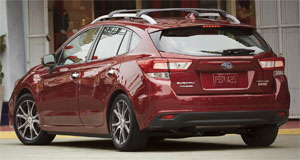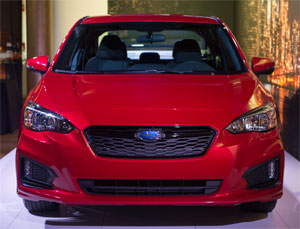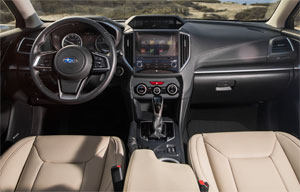2017 Subaru Impreza
The Subaru brand continues to grow and grow with rising sales in each of the last 10-years. The reasons for that are many, but it really comes down to building highly reliable cars and utilities, most with standard all-wheel drive. So let’s see if their newest offering, the 2017 Impreza, can keep that hot streak going.
 This 2017 Subaru Impreza compact not only rides on the brand’s new global architecture; but it’s also the first Impreza built here in the U.S., at their assembly plant in Lafayette, Indiana.
This 2017 Subaru Impreza compact not only rides on the brand’s new global architecture; but it’s also the first Impreza built here in the U.S., at their assembly plant in Lafayette, Indiana.
Both sedan and 5-door hatchback Imprezas are once again available; we opted for the sportier 5-door. No word on when the STI variants will get the new chassis.
So, there’s still only a normally aspirated 2.0-liter boxer-4 providing Impreza power. But, a host of new parts, as well as direct-injection, result in a small increase in power from 148 to 152-horsepower along with 145 lb-ft. of torque.
A 5-speed manual transmission remains standard, but most will come equipped with a CVT. And while it’s been one of the better CVTs for a while now, others are improving and this one is no longer a standout. All but base trim get manual shift mode with paddle shifters. And, yes, all-wheel-drive is standard.
 Exterior styling has certainly been updated; but with such a familiar face, things don’t appear radically different. And most Subaru owners will agree that’s actually a really good thing.
Exterior styling has certainly been updated; but with such a familiar face, things don’t appear radically different. And most Subaru owners will agree that’s actually a really good thing.
The 5-door hatch is noticeably sleeker than before, and the tail lights take up more real estate.
Space is even more noticeably increased inside, and Subaru trademarks of easy ingress and great visibility are still here.
Seating position is fairly high, while front seats remain on the firm side.
The infotainment system makes a huge jump in usability and that is very much appreciated. The screen itself is bigger, with larger virtual buttons. Traditional control knobs have grown in size as well.
 The familiar upper dash display is still present, and there always seems to be something happening on it. It does provide lots of information, although it’s just outside of your normal line of sight.
The familiar upper dash display is still present, and there always seems to be something happening on it. It does provide lots of information, although it’s just outside of your normal line of sight.
Over in the driver’s I.P., there’s plenty of data as well, presented in a very clear fashion.
With more space for rear seat passengers, cargo volume falls a bit to 20.8 cubic-ft., but max capacity is “max-er” at 55.3 cubic-ft.
Without a doubt, the Impreza’s new chassis feels much more solid on the road compared to previous generations. Just about every aspect of performance has gotten tighter, throttle response is certainly crisper, and it’s an overall more enjoyable experience behind the wheel.
Yet that tighter demeanor is contrasted with additional sound deadening, leaving you feel a little more isolated in the cabin, due to its now very quiet nature.
And without a doubt, at our test track, the Impreza was much less of a snoozer, and more stimulating than it’s ever been before. It barnstormed through our slalom course with great balance and a “glued to the pavement” feel. Steering feedback is less artificial, and turn-ins were so quick it felt like Subaru also added 4-wheel steering.
It’s not quite Mazda3 or VW Golf fun, but certainly a drastic improvement.
With times of 9.6-seconds to 60, and 17.4 in the ¼-mile at 81 miles-per-hour, it’s not a rocket off the line, but the engine is very responsive which helps it feel better in real world use.
By the way, those times are exactly the same as the last Impreza we tested back in 2012.
Subaru’s available EyeSight includes Pre-Collision braking, and it worked flawlessly as always in our crash barrier test; even in some light rain. This year it adds Reverse Automatic Braking as well.
Government Fuel Economy Ratings for our CVT hatchback are 28-City, 37-Highway, and 31-Combined; though our average was a bit disappointing at 28.5 miles-per-gallon of Regular.
Still, the Energy Impact Score is a good one, with use of just 10.6-barrels of oil per year with C02 emissions of 4.7-tons.
Base pricing is up just $100 over last year and remains very competitive considering standard all-wheel-drive. Sedans start at $19,215, hatchbacks at just $500 more.
The 2017 Subaru Impreza, may not be as big of a leap forward as last generation; but truth be told, it didn’t have as far to go to be highly competitive among a host of really great cars in the compact segment. And by offering both more room and comfort, as well as way more handling fun; it has become an even better option than it was before. Consider us Imprezed.
Specifications
- Engine: 2.0-liter boxer-4
- Horsepower: 152
- Torque: 145 lb-ft.
- 0-60 mph: 9.6 seconds
- 1/4 mile: 17.4 seconds @ 81 mph
- EPA: 28 mpg city / 37 mpg highway
- Energy Impact: 10.6 barrels of oil/yr
- CO2 Emissions: 4.7 tons/yr
2025 Volkswagen ID. Buzz
Volkswagen Brings Beetlemania Level Of Excitement To Minivan Segment
The duty of upholding Volkswagen’s heritage has most recently been delegated to small legacy car names like Golf and Jetta. But hold on! A much larger, totally modern take on VW’s classic microbus has just buzzed over the horizon— the all-electric ID. Buzz. It’s been at the top of our minds since we first saw the concept back in 2017. Well, it’s finally here, so let’s get our groove into drive!
This 2025 Volkswagen ID. Buzz has indeed created the most buzz around Volkswagen since the Beetle’s return to the U.S. in the late 1990s. We couldn’t drive it anywhere without drawing a crowd. No wonder, just about everyone has a VW Microbus story to tell, and seeing this reimagined version rolling down the street brings back all those memories.
VW really pulled it off as far as we’re concerned, as it looks great without appearing over the top. All the cues are here: Big VW logo front and center, lots of greenhouse including A-pillar windows and mini sliders for the second-row passengers, D-pillar air vents, and two-tone wheels. And while its appearance may be pure retro, its drivetrain is far from it, as the ID. Buzz is all-electric, and unlike the new Beetle, the Buzz does retain the original Microbus’ rear-drive architecture.
Powering those rear wheels is a 210-kW motor drawing juice from a 91-kWh battery for a range of 234 miles; 200-kW max charging will get you to 80% in about 26 minutes. Buyers can add another small 80-kW motor up front for 4motion all-wheel-drive and an increase of total output from 282 to 335 horsepower with a combined 512 lb-ft of torque. It uses the same battery, but range estimates drop just slightly to 231 miles. But while those numbers are modest, we also found them to be quite conservative, as we observed as many as 287 miles available in our all-wheel-drive tester’s gauge display and were on pace for 273 miles in our driving loop.
One throwback theme that may be a turnoff to some is that it’s quite a step up into the Buzz’s front seats, but there’s certainly a commanding view of the road once you climb in. Second row seating can be either a three-place bench or a pair of captain’s chairs, so there’s generous room for seven or six passengers. The captain’s chairs in our Pro S Plus offer good support and very easy access to the third row.
Lots of flexibility too with the option to simply fold the seats or remove them altogether.
With the sliding side doors and a wide opening rear hatch, there’s plenty of access for loading big sport utility amounts of cargo. Lots of flexibility too with the option to simply fold the seats or remove them altogether, and the ability to create a full-length flat floor with a rear cargo shelf that covers some handy removable storage bins. There’s 18.6 cubic-feet of space behind the third row, 75.5 behind the second, and a max of 145.5. That’s more than a Chevrolet Tahoe. For smaller items, there are lots of cubbies throughout the cabin, along with a standard Buzz Box that can be moved to multiple locations.
With a design that prioritizes retro form and modern function over aero efficiency, the 4motion equipped ID. Buzz earns a Fair efficiency rating, using 42-kWh of electricity per 100 miles, and we weren’t sure what to expect at our Mason Dixon test track.
What we found was great torque off the line and drama free launches to 60 in just 5.3 seconds. It was very stable at speed and power delivery stayed steady most of the way down the track until we reached about 90 mph, when it began to taper off just before we finished the quarter-mile in 14.0 seconds flat at 97 mph.
With 1,200-lbs. of battery weight nestled in its 127.5-inch wheelbase, the Buzz felt planted to the pavement through our handling course. There was quite a bit of body roll to deal with, but surprisingly little understeer. In panic braking runs, pedal response was inconsistent, feeling soft at times, pushing back hard at others; but through it all, results were quite good, stopping from 60 in an average of just 108 feet.
Three interior themes are available, this Dune is the brightest, featuring coastal inspired wood optic dash décor, “gray and clay” leatherette surfaces, and a high-mounted central 12.9-inch touchscreen. Pricing starts with a rear-wheel-drive Pro S at $61,545; this Pro S Plus begins at $65,045, add another $4,500 for 4motion, which brings a few extra features along with all-wheel drive.
Retro design with old-school VW charm, modern EV drivetrain, big SUV capacity merged with minivan flexibility; it all comes together in this 2025 Volkswagen ID. Buzz. It’s easily one of the coolest rides of the year and one that will likely keep Volkswagen dealers buzzing for years to come, and that’s something no other people and things mover can say.
Specifications
As Tested
- Motor Setup: Dual-Motor AWD
- Battery Size: 91-kWh
- Horsepower: 335
- Torque: 512 lb-ft
- EPA Range: 231 miles
- 0-60 mph: 5.3 seconds
- 1/4 Mile: 14.0 seconds at 97 mph
- Braking, 60-0: 108 feet
- MW Test Loop: ~ 273 miles













































